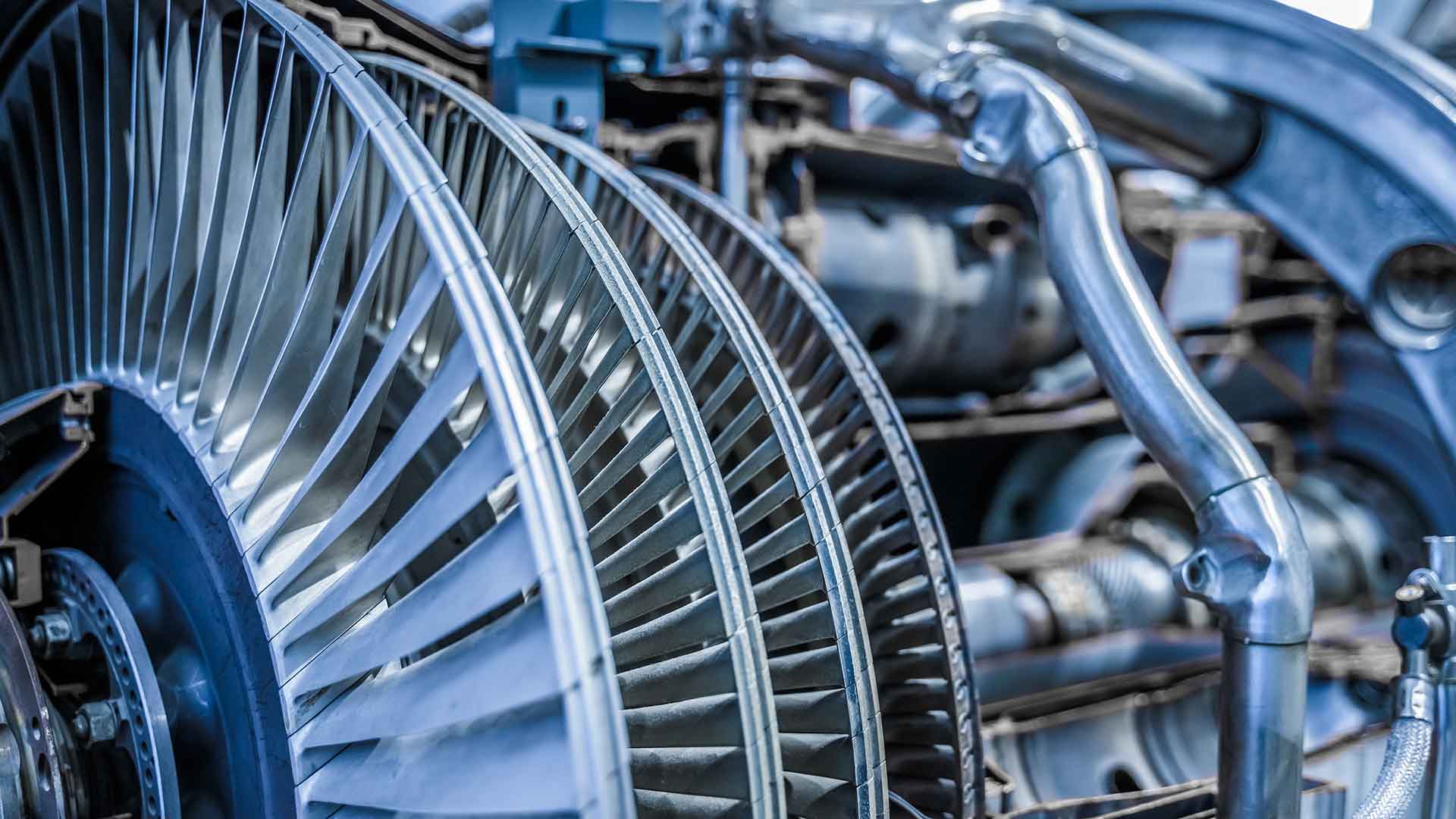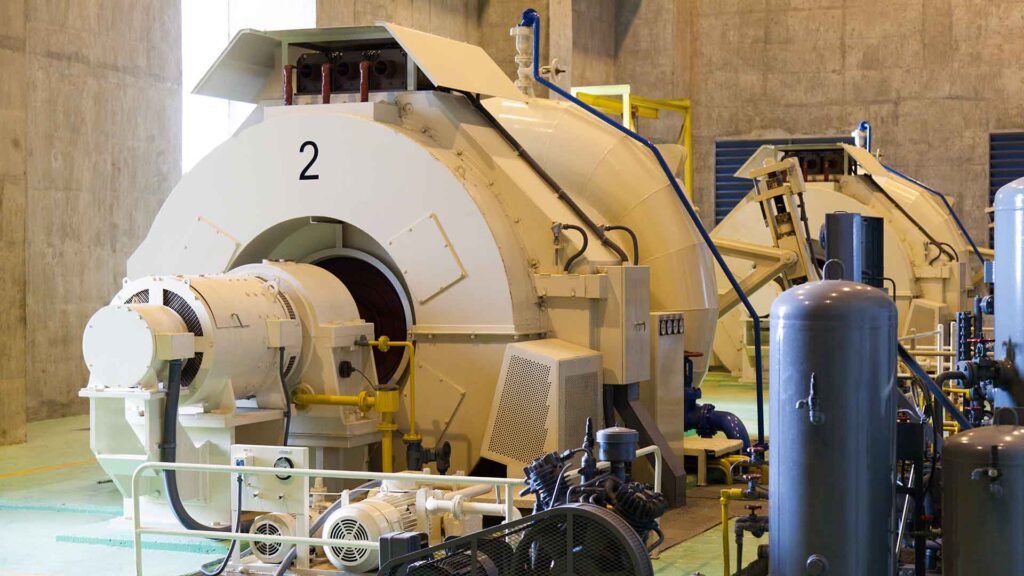A Combined Cycle Gas Turbine (CCGT) is a sophisticated power plant technology that integrates gas and steam turbines into a single system to enhance efficiency.
The process captures waste heat from the gas turbine and uses it to produce steam for additional electricity generation.
This design significantly boosts energy utilization while lowering emissions, posing CCGTs as an essential solution as we try to find cleaner and more efficient power generation options.
What is a Combined Cycle Gas Turbine, and How Does it Work?
A CCGT is a turbine system that generates electricity. Unlike an open-cycle gas turbine, a combined-cycle type uses two cycles or processes instead of one to produce power.
These two processes use fuel and capture the resulting steam to produce electricity on the second cycle.
The Two-cycle Process
1. The Gas Cycle: The gas turbine compresses air and mixes it with heated fuel to a very high temperature. This hot air and fuel mixture moves through the gas turbine blades, making them spin. The spinning turbine drives a generator that generates electricity.
2. The Steam Cycle: The leftover heat from the gas turbine makes steam, which powers a steam turbine to produce even more electricity.
The two processes make the CCGT more efficient than traditional power plants because they take the same amount of fuel to create electricity, first with conventional means and then with steam, using it twice.
Key Elements of a Combined Cycle Gas Turbine
A CCGT comprises a gas turbine, a steam turbine, and a heat recovery steam generator.
Gas Turbine
The gas turbine of a CCGT converts the combustion energy of a gas or liquid fuel into mechanical energy. Gaseous fuels include the most commonly used natural gas, propane, or hydrogen, while liquid fuels include diesel and liquefied petroleum gases.
During this process filtered and compressed air is injected into the combustion chamber for use as an oxidizer.
Part of the compressed air injected into the combustion chamber is also used as a coolant during the gas turbine’s first stages.
Steam Turbine
The steam turbine in a CCGT is a highly reliable and straightforward component with a long history in the power industry. Up to 80% of the world’s electricity is generated using steam turbines.
In a combined cycle power plant, the steam turbine is a key element within the Rankine cycle. High-pressure steam, produced in the heat recovery steam generator (HRSG), is expanded to a condensing pressure within the turbine.
During this expansion process, a portion of the steam’s mechanical energy is transferred to the condenser, where the water vapor is cooled and condensed, where the water vapor is cooled and condensed into liquid water.
This condensate then contributes to the subsequent pressure increase in the cycle.
One or two pumping stages from the condenser outlet raise the water pressure, directing it back to the HRSG. Here, the water is reheated, evaporated, and superheated at a constant pressure, creating steam that is reintroduced into the turbine.
This cyclical process continues, with the steam turbine in a combined cycle operating similarly to those found in traditional thermal power plants.
Heat Recovery Steam Generator
An HRSG is designed to capture and convert the energy from a gas turbine’s exhaust gases into steam.
This steam can serve various purposes: it can be used to generate electricity, power industrial processes, or supply heat for district heating systems.
HRSGs are typically classified based on whether or not they include an afterburner:
- Non-Afterburning HRSGs: The most common type used in combined cycles. These function as heart exchangers, transferring the heat from turbine exhaust gases to the steam-water cycle through convection.
- Afterburning HRSGs: These feature additional burns installed upstream of the boiler. The burners utilize excess oxygen in the turbine exhaust to generate more heat without exceeding the temperature limits of insulating materials.
The choice in HRSG must consider factors like the plant’s operational needs and long-term performance rather than focusing solely on price and construction time.
Applications of Combined Cycle Gas Turbines
Thanks to their efficiency, versatility, and relatively low environmental impact, CCGTs play a vital role in modern energy systems. Their applications span a wide range of industries and settings, making them a key technology in global energy production.
Power Generation
The primary use of power plants is to generate electricity. They can achieve high thermal efficiency, making them an attractive choice for utility companies aiming to meet energy demand while minimizing fuel consumption and emissions.
Industrial Applications
Industries rely on CCGT for both electricity and to process heat.
CCGTs can serve as a cogeneration solution in facilities requiring significant amounts of thermal energy, such as chemical plants, refineries, and manufacturing facilities. They supply power and steam simultaneously.
Integration with Renewable Energy
CCGTs are increasingly being used to complement renewable energy systems like wind and solar.
Their ability to ramp up quickly makes them ideal for balancing the grid during fluctuations in renewable energy output. The integration supports the transition to a more sustainable energy mix without compromising grid stability.
Peaking Power Plants
CCGTs are often deployed in peaking power plants, which are designed to operate during periods of high electricity demand. Their flexibility and efficiency make them well-suited for this role, ensuring a reliable power supply during peak times while minimizing fuel usage.
Advantages
While all turbine systems have advantages and disadvantages, the CCGT is versatile and eco-friendly.
- Efficient: The CCGT has a high thermal efficiency. The two-cycle system uses less fuel and results in a higher electricity generation efficiency.
- Flexible: While some turbines must maintain a minimum baseline before power can be created, the CCGT can operate at a partial load while staying stable, allowing it to respond to peak times.
- Low Emissions: The CCGT’s efficient system also makes it eco-friendly. Compared to coal-fired power plants, it has a smaller carbon footprint and emits fewer pollutants and greenhouse gases.
- Starts and Loads Quickly: Power plants fueled by CCGT can start up and respond quickly to the demand for electricity, which makes them particularly well-suited to providing peak-load power.
- Base or peak source: In addition to starting quickly, CCGT can also operate as a base load source. This allows them to run continuously as a base of power or ramp up when there is a sudden spike in demand.
Disadvantages
While combined cycle gas turbines offer high efficiency and versatility, they are not without challenges. Some of the disadvantages stem from economic, environmental, and technical considerations that may impact their feasibility in certain scenarios.
- Requires external power: Although the CCGT is efficient with its two cycles, it needs help starting from an external power source. The two-cycle system also needs external fuel to start the compressor. Power plants most commonly use natural gas and biogas.
- Carbon Dioxide: While the CCGT is more efficient and produces fewer greenhouse gases, the two-cycle system still produces carbon dioxide and contributes to a carbon footprint.
- High maintenance: Because the CCGT creates high temperatures, first in the fuel-burning stage and later when capturing steam, it generally requires higher amounts and more frequent maintenance.
- Elevated cost: Combined-cycle gas turbines are expensive to purchase and can be expensive to maintain. This may prevent them from being installed in smaller power plants and leave them for larger plants.
Conclusion
Combined-cycle gas turbines have revolutionized power generation with their efficiency, adaptability, and lower emissions. By combining the strengths of gas and steam turbines, they optimize energy production while addressing environmental concerns.
Despite challenges like reliance on natural gas, CCGTs remain a pivotal technology for advancing sustainable energy solutions and a new generation of jobs in the energy industry.
As global energy needs and environmental priorities evolve, CCGTs will continue to be key in building a cleaner and more efficient power infrastructure.
Frequently Asked Questions
Here are some frequently asked questions about the combined cycle gas turbine.
What is the difference between simple cycle and combined cycle gas turbines?
The main difference is that a CCGT uses the waste heat from the gas turbine to create more electricity. A simple cycle plant produces 50% less electricity than a CCGT.
What is the difference between CCGT and CHP?
CCGT is a gas-powered power plant that combines two or more cycles to increase efficiency. Combined Heat and Power (CHP) technology uses standard fuel to simultaneously produce electricity and thermal energy.
What are two different starting methods for gas turbine engines?
CCGT can be started with an air motor or a DC motor.
What are the three basic types of gas turbines?
The three types are turbojet, industrial gas turbine, and aero-derivative gas turbine.









